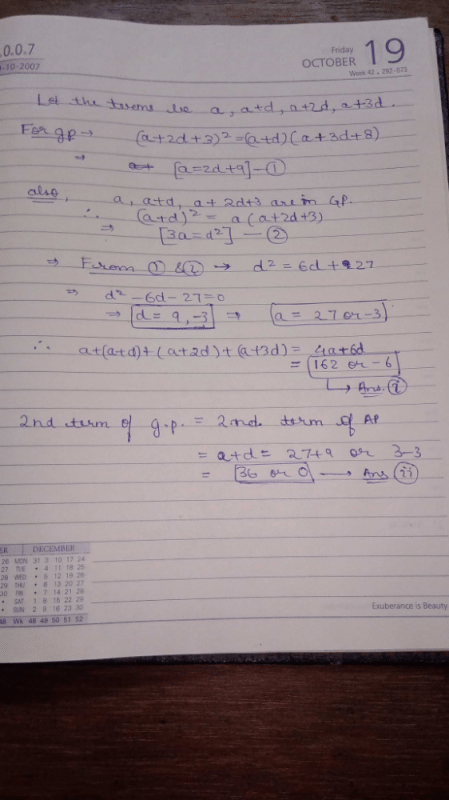JEE Exam > JEE Questions > If the third and fourth terms of an arithmeti...
Start Learning for Free
If the third and fourth terms of an arithmetic sequence are increased by 3 and 8 respectively, then the first four terms form a geometric sequence. find i) the sum of the first four terms of ap ii) the second term of the gp?
Most Upvoted Answer
If the third and fourth terms of an arithmetic sequence are increased ...
Problem: If the third and fourth terms of an arithmetic sequence are increased by 3 and 8 respectively, then the first four terms form a geometric sequence. Find i) the sum of the first four terms of AP ii) the second term of the GP?
Solution:
Let us assume that the first term of the arithmetic sequence is 'a' and the common difference is 'd'. Then, the four terms of the arithmetic sequence are:
a, a + d, a + 2d, a + 3d
After increasing the third and fourth terms by 3 and 8 respectively, we get the following sequence:
a, a + d, a + 2d + 3, a + 3d + 8
It is given that the first four terms form a geometric sequence. Therefore, we can write:
(a + d) / a = (a + 2d + 3) / (a + d) = (a + 3d + 8) / (a + 2d + 3) = r (let)
From the first ratio, we get:
a + d = ar
From the second ratio, we get:
a + 2d + 3 = ar^2
From the third ratio, we get:
a + 3d + 8 = ar^3
Now, we can solve for 'a' and 'd' using the first two equations:
a + d = ar
a + 2d + 3 = ar^2
Subtracting the first equation from the second, we get:
d + 3 = ar(r - 1)
Substituting the value of 'a + d' from the first equation, we get:
d + 3 = r(a + d - d)
d + 3 = r(a)
Substituting this value in the first equation, we get:
a + r(a) = ar
a = r(a) - r(a - d)
a = rd
Therefore, the first four terms of the arithmetic sequence are:
rd, rd + d, rd + 2d, rd + 3d
We know that the first four terms form a geometric sequence. Therefore,
(rd + d) / rd = (rd + 2d) / (rd + d) = (rd + 3d) / (rd + 2d) = r
Solving, we get:
r = 1 + (sqrt(5)) / 2
Therefore, the first four terms of the arithmetic sequence are:
a = rd = d((sqrt(5)) - 1) / 2
d = (a + 3d + 8) / (r^3)
Substituting the values of 'a' and 'r', we get:
d = 2
Therefore, the first four terms of the arithmetic sequence are:
a = d((sqrt(5)) - 1) / 2 = (sqrt(5) - 1)
The four terms of the geometric sequence are:
(sqrt(5) - 1), 3sqrt(5), 9 + 3sqrt(5), 27 + 12sqrt(5)
Therefore, the sum of the first four terms of the arithmetic sequence is:
a + (a + d) + (a + 2
Solution:
Let us assume that the first term of the arithmetic sequence is 'a' and the common difference is 'd'. Then, the four terms of the arithmetic sequence are:
a, a + d, a + 2d, a + 3d
After increasing the third and fourth terms by 3 and 8 respectively, we get the following sequence:
a, a + d, a + 2d + 3, a + 3d + 8
It is given that the first four terms form a geometric sequence. Therefore, we can write:
(a + d) / a = (a + 2d + 3) / (a + d) = (a + 3d + 8) / (a + 2d + 3) = r (let)
From the first ratio, we get:
a + d = ar
From the second ratio, we get:
a + 2d + 3 = ar^2
From the third ratio, we get:
a + 3d + 8 = ar^3
Now, we can solve for 'a' and 'd' using the first two equations:
a + d = ar
a + 2d + 3 = ar^2
Subtracting the first equation from the second, we get:
d + 3 = ar(r - 1)
Substituting the value of 'a + d' from the first equation, we get:
d + 3 = r(a + d - d)
d + 3 = r(a)
Substituting this value in the first equation, we get:
a + r(a) = ar
a = r(a) - r(a - d)
a = rd
Therefore, the first four terms of the arithmetic sequence are:
rd, rd + d, rd + 2d, rd + 3d
We know that the first four terms form a geometric sequence. Therefore,
(rd + d) / rd = (rd + 2d) / (rd + d) = (rd + 3d) / (rd + 2d) = r
Solving, we get:
r = 1 + (sqrt(5)) / 2
Therefore, the first four terms of the arithmetic sequence are:
a = rd = d((sqrt(5)) - 1) / 2
d = (a + 3d + 8) / (r^3)
Substituting the values of 'a' and 'r', we get:
d = 2
Therefore, the first four terms of the arithmetic sequence are:
a = d((sqrt(5)) - 1) / 2 = (sqrt(5) - 1)
The four terms of the geometric sequence are:
(sqrt(5) - 1), 3sqrt(5), 9 + 3sqrt(5), 27 + 12sqrt(5)
Therefore, the sum of the first four terms of the arithmetic sequence is:
a + (a + d) + (a + 2
Community Answer
If the third and fourth terms of an arithmetic sequence are increased ...


|
Explore Courses for JEE exam
|

|
Similar JEE Doubts
Question Description
If the third and fourth terms of an arithmetic sequence are increased by 3 and 8 respectively, then the first four terms form a geometric sequence. find i) the sum of the first four terms of ap ii) the second term of the gp? for JEE 2025 is part of JEE preparation. The Question and answers have been prepared according to the JEE exam syllabus. Information about If the third and fourth terms of an arithmetic sequence are increased by 3 and 8 respectively, then the first four terms form a geometric sequence. find i) the sum of the first four terms of ap ii) the second term of the gp? covers all topics & solutions for JEE 2025 Exam. Find important definitions, questions, meanings, examples, exercises and tests below for If the third and fourth terms of an arithmetic sequence are increased by 3 and 8 respectively, then the first four terms form a geometric sequence. find i) the sum of the first four terms of ap ii) the second term of the gp?.
If the third and fourth terms of an arithmetic sequence are increased by 3 and 8 respectively, then the first four terms form a geometric sequence. find i) the sum of the first four terms of ap ii) the second term of the gp? for JEE 2025 is part of JEE preparation. The Question and answers have been prepared according to the JEE exam syllabus. Information about If the third and fourth terms of an arithmetic sequence are increased by 3 and 8 respectively, then the first four terms form a geometric sequence. find i) the sum of the first four terms of ap ii) the second term of the gp? covers all topics & solutions for JEE 2025 Exam. Find important definitions, questions, meanings, examples, exercises and tests below for If the third and fourth terms of an arithmetic sequence are increased by 3 and 8 respectively, then the first four terms form a geometric sequence. find i) the sum of the first four terms of ap ii) the second term of the gp?.
Solutions for If the third and fourth terms of an arithmetic sequence are increased by 3 and 8 respectively, then the first four terms form a geometric sequence. find i) the sum of the first four terms of ap ii) the second term of the gp? in English & in Hindi are available as part of our courses for JEE.
Download more important topics, notes, lectures and mock test series for JEE Exam by signing up for free.
Here you can find the meaning of If the third and fourth terms of an arithmetic sequence are increased by 3 and 8 respectively, then the first four terms form a geometric sequence. find i) the sum of the first four terms of ap ii) the second term of the gp? defined & explained in the simplest way possible. Besides giving the explanation of
If the third and fourth terms of an arithmetic sequence are increased by 3 and 8 respectively, then the first four terms form a geometric sequence. find i) the sum of the first four terms of ap ii) the second term of the gp?, a detailed solution for If the third and fourth terms of an arithmetic sequence are increased by 3 and 8 respectively, then the first four terms form a geometric sequence. find i) the sum of the first four terms of ap ii) the second term of the gp? has been provided alongside types of If the third and fourth terms of an arithmetic sequence are increased by 3 and 8 respectively, then the first four terms form a geometric sequence. find i) the sum of the first four terms of ap ii) the second term of the gp? theory, EduRev gives you an
ample number of questions to practice If the third and fourth terms of an arithmetic sequence are increased by 3 and 8 respectively, then the first four terms form a geometric sequence. find i) the sum of the first four terms of ap ii) the second term of the gp? tests, examples and also practice JEE tests.

|
Explore Courses for JEE exam
|

|
Signup to solve all Doubts
Signup to see your scores go up within 7 days! Learn & Practice with 1000+ FREE Notes, Videos & Tests.


























